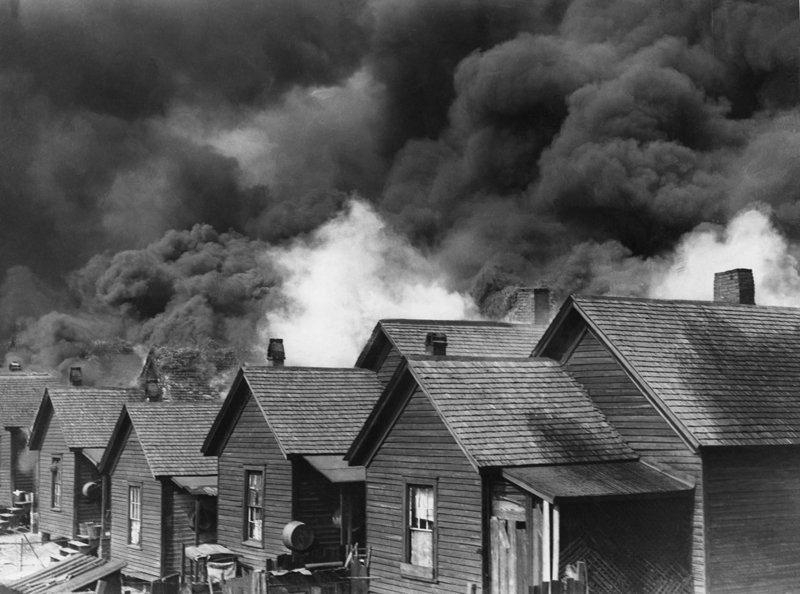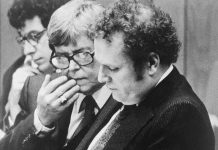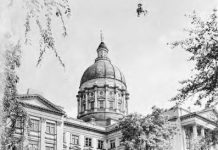
May 21, 1917 B/W photo of the great fire in Atlanta, Georgia. Flames jumped from roof to roof across blocks of wood-shingled houses. More than 4,000 Atlantans were homeless before the wind changed and the fire died. (From the collection of Kenneth Rogers, AJC staff photographer).

A half-century after Sherman burned Atlanta, the core of the city went up in flames again. The Great Atlanta Fire of 1917 destroyed 1,938 buildings, wiped out 300 acres of real estate, and left more than 10,000 people homeless—almost a tenth of the city’s residents.
The Great Fire actually resulted from four small fires that all started on the morning of Monday, May 21, 1917. First, flames were spotted in a downtown cotton warehouse. Then there was a fire in the West End. Thirty minutes later, firefighters were summoned to a blaze on Woodward Avenue that burned down several homes. Barely an hour after the first call, firefighters were dispatched the fourth outbreak. Flames flicked across the roof of a building just off Decatur Street that had once been a “pest house,” or quarantine center, and was used as a storage facility by Grady Hospital. When the firemen arrived, they found stacks of old cotton mattresses aflame. Their firetruck malfunctioned, and, with all other units fighting the first three fires, a blaze that should easily have been contained spread. Fueled by windstorms and fed by shingle-roofed wooden cottages, the fire spread for more than fifty city blocks, reaching from Decatur Street to the edge of Piedmont Park. Fire crews headed to Atlanta from cities across Georgia and nearby states, some coming on special trains from Nashville and Chattanooga. Soldiers at Fort McPherson marched four miles to Atlanta to man bucket brigades.
By afternoon, fire chief William “Bill” Cody decided that the only way to stop the fire from spreading would be to dynamite stately homes in its path, creating a break the flames could not cross. While Cody oversaw firefighting efforts, mayor Asa Candler (better known as former head of Coca-Cola), drove to the headquarters of DuPont Powder Company to fetch crates of dynamite. Explosives experts worked quickly, dodging flames to set up crates of TNT in the foyers of mansions along Ponce de Leon Avenue. Onlookers gasped as the explosions sent homes sailing into the air. Eventually, the dynamiting created a gulch that the fire could not cross, and the blaze was contained.
However, for weeks, the city was shrouded in smoke and ash. Houses collapsed in on themselves, and wooden frames and shingles fell into cellars, creating smoldering fire pits. Thousands of homeless Atlantans camped in Piedmont Park or vacant lots on Edgewood Avenue, while others slept in the civic auditorium, in church sanctuaries, and in hotel and theater lobbies. First aid stations were set up in Downtown offices and the headquarters of fraternal organizations, like the Odd Fellows Hall on Auburn Avenue.
The Great Fire permanently altered Atlanta. The single-family homes near Downtown were replaced by apartment buildings that catered to the newly homeless—and the wartime surge in the city’s population. The development patterns along Boulevard, North Avenue, and Ponce de Leon are a direct result of the fire’s destruction.
Great Atlanta Fire of 1917 photograph courtesy Library of Congress










![The North Carolina Museum of Natural Sciences’ newest exhibit is a [pre]historic first](https://cdn2.atlantamagazine.com/wp-content/uploads/sites/4/2024/04/DD-3-100x70.jpg)


